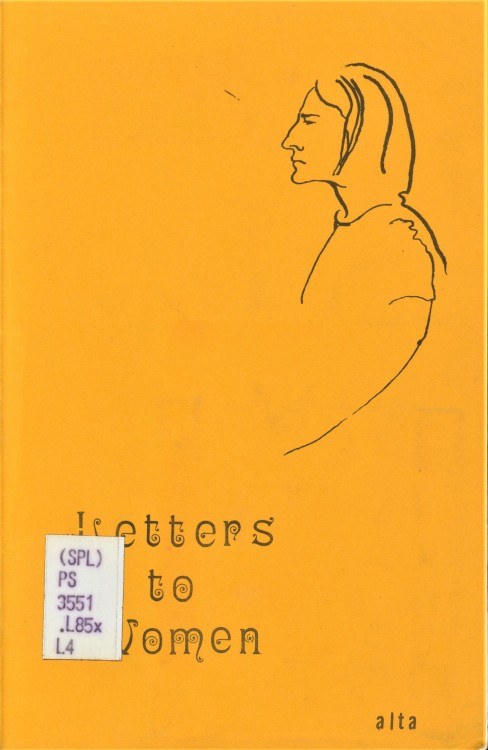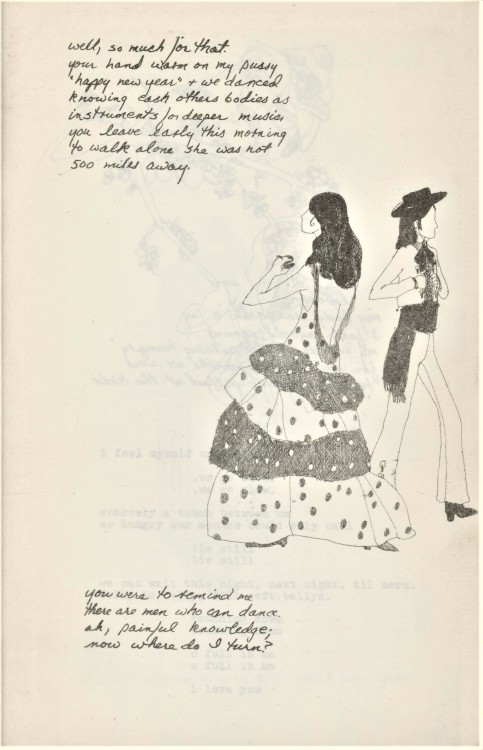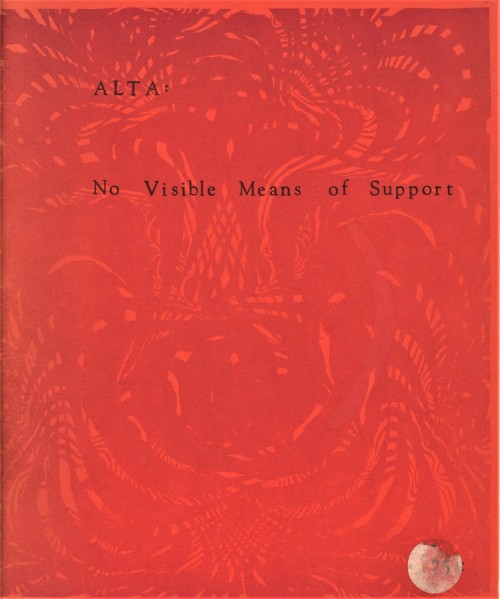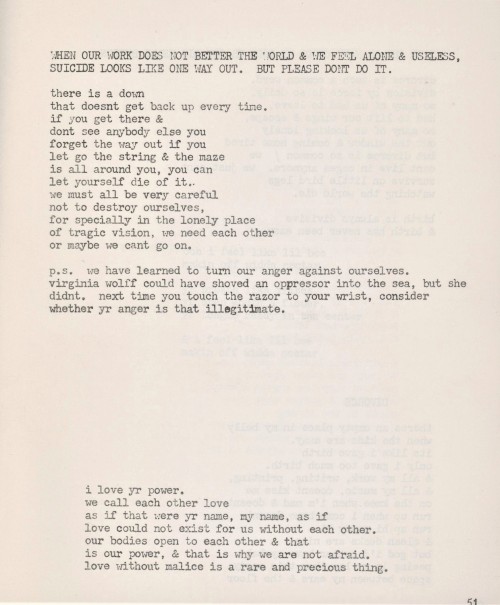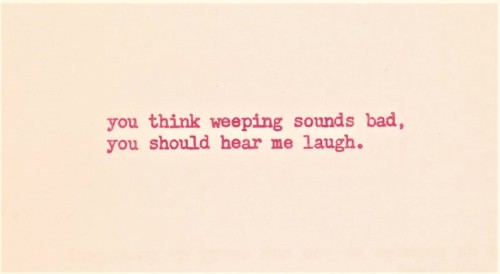#second wave feminism
First Feminist Press!
Shameless Hussy Press
With the stress of Roe vs Wade potentially facing a repeal this summer, we want to let the women in our lives know they are not alone in their frustration. The fight women have been waging for their intellectual and bodily freedom has been a long one, so we wanted to revisit some history about the first women-owned feminist press in California, the Shameless Hussy Press! Poet and soon to be publisher Alta Gerrey founded the press in Oakland, California, in 1969, and would publish four women who later became prominent feminist writers: Pat Parker,Mitsuye Yamada,Ntozake Shange, and Susan Griffin. Alta published her own titles under her Shameless Hussy Press imprint, including three poetry collections preserved in our collection:Letters to Women, published around 1970;Song of the Wife; Song of the Mistress, published in 1971;No Visible Means of Support, published in 1971.
Alta’s sarcastic and straightforward writing style is reflected in the Shameless Hussy Press aesthetic. In her first collection, Letters to Women, she includes the iconicfeminist symbol of a fist within the symbol of Venus and her copyright statement reads:
for underground reproduction without profit, there is no copyright. for moneymakers, this is copyright, and you gotta pay.
Alta emphasizes the aid of her friends and family in producing her book, and poetry aimed at letting women know that they were not alonein whatever injustices and hardships they faced, whether gender inequality and sexism, marriage and divorce, rape, mental illness, or raising children.
Alta’s second collection, Song of the Wife; Song of the Mistress, with drawings by Martha Kuech, reflects the intimacy the poet felt with her readers and how she used poetry as the outlet for emotions that could be a burden too heavy to carry at times. Letters to Women is dedicated “to every woman who is as isolated as i,” but Song of the Wife; Song of the Mistress "isn’t dedicated to anybody. eat yr hearts out.” Alta had a love for improper grammar, punctuation, and unconventional spelling. The first half of this second book reproduces a handwritten cursive script, presumably Alta’s handwriting, and the second half switches back to typewriter print. This title and Alta’s third collection, No Visible Means of Support, were both published after the Shameless Hussy Press had moved down the Bay to San Lorenzo, California, from its original location in Berkeley. Alta made the choice to move her independent press after the sabotage of a friend’s press in the same area, as well as to protect her daughter and herself from death threats she received for her work in the lesbian, feminist, and activist communities.
Shameless Hussy Press was the first to publishNtozake’s Shange’s poetic performance work, For Colored Girls Who Have Considered Suicide When the Rainbow Is Enuf, which was later adapted into an Obie award-winning Broadway theater production. In 1976, Shameless Hussy publishedCamp Notes and Other Poems by Mitsuye Yamada, revolving around her experiences in the internment camps and the pain she felt at being perceived as an outsider.
The formation of the Shameless Hussy Press by Alta and the Women’s Press Collective by Judy Grahn, with aid from Pat Parker (whoI posted about earlier), was quite inspirational for second wave of feminism. The four women who brought the feminist and lesbian publishing community to the foreground in California, Alta, Susie Griffin, Judy Grahn, and Pat Parker, had all met originally as neighbors over tea, but decided it was time to take action in their communities. Alta said in an interview that the group would often argue over how political their writing should be, wondering whether they should, “stick to the personal. [but] Susie kept saying, ‘the personal is political.’”
Griffin’s works were said to have launched ecofeminism in the United States as she rose to become one of the most influential American feminist writers of the 20th century. Alta’s Shameless Hussy Press gave these influential women the opportunity to be published outside the patriarchy of mainstream publishing, allowing them to completely claim their work as their own. Shameless Hussy ran from 1969-1989, despite being a one-woman-publishing house, publishing over fifty titles in its 20-y3qr existence.
–Isabelle, Special Collections Undergraduate Writing Intern
Post link

Erica Jong: Fear of Flying (1973)
The 1960′s spurred a large feminist movement, also known as “second-wave feminism”. This of course refers to the first large feminist movement for women’s suffrage in the 1920′s, making the 1960′s movement the second “wave” of feminism. Prior to the movement, women were expected to only aspire to and live as a mother and wife. There was an extremely small amount of women in the workforce as a result of this, and women who had other ambitions than the ones enforced suffered widely. These women struck back, and like all aspects of life, clothing was affected. Wishing to shed the conservative idea of fashion previously held, women made a big change in their everyday style. The mini-skirt became a huge symbol of women’s freedom after its creation in 1965. Women were allowed to express their defiance, sexuality, and carefree attitude through these shorter hemlines. To this day the miniskirt remains symbolic not only of the feminist movement, but of the 60′s as a whole.

March for Women’s Liberation

Passionate Supporters of the Miniskirt

Miniskirt Takeover

Save the Mini
Information Credits and More Information:
Not to be a feminist on main, but reading the 1997 edition of The Feminine Mystique with all three of Betty Friedan’s forewords is really interesting. Reading from most recent foreword back to the original text in the beginning of the book is like a walk backwards through the decline of feminism. As time went on, Friedan became less and less radical and forceful in her thought.
This culminates in her statements in the 1997 foreword that feminism is now more of a united front between men and women and that issues like abortion are almost “obsolete” (paraphrasing because it’s early in the morning and I don’t want to dig for the quotes). She walks her determined radicalism back into a tame moderate liberalism.
This process, especially the statement about abortion, is particularly interesting because it represents a dream unfulfilled. Friedan, and other feminists, slowed down, perhaps becoming complacent, as the century ended, and now we live in an era of uncertain bodily autonomy, the rise of “men’s rights” (violently misogynist) movements, and the loss of the social awareness so hard-won just 30-50 years ago.
As I begin The Feminine Mystique, I’m just finishing Men Who Hate Women: From Incels to Pick-Up Artistis by Laura Bates (a 2020 book dealing with the online MGTOW, MRA, and incel movements). Unbeknownst to me when I started Men Who Hate Women at the beginning of the year, I think I’ve created a particularly enlightening reading order. It’s interesting to see Friedan, in her 1997 foreword, confidently announce the end of the sort of misogyny Bates investigates in her 2020 book.
All this is not to discredit the work that Friedan has done. She and her work were, and continue to be, revolutionary in their impact and genius in their craft. I’m still less than a quarter of the way through the original text of The Feminine Mystique and already I’ve been moved almost to tears thinking of my grandmother, who I have the incredible fortune to know very well. The Western world is changed (and improved) perhaps permanently by Friedan’s work, but it’s important to consider her walking back of feminist ideals near the end of her life when reading her work.
I plan on doing some more research into Friedan. This is the first work of hers I’ve read, and I’m only broadly and tangentially aware of her larger set of work and ideas, so if this turns out to be a gross misreading of the 1997 and 1973 forewords, I’ll come back to this and add on.
Okay, Gen Z, younger millennials, please tell me, are you aware of what the title Ms. means? And how to pronounce it?
Because I just listened to several young 20-somethings pronounce it Miss and talk about how it means you’re not married. And…I’m feeling weird about it, considering that’s the title I use.
(It means my marital status is none of your business. I use it because I’m married but I kept my maiden name so I’m not Mrs. anyone.)
These comments really are fascinating and it seems especially people whose first language isn’t English aren’t sure about this, which is fair. But as I suspected some young folks aren’t clear either?
It seems like Ms. has been conflated with Miss and Miss has fallen out of favor, which is fair, but the meanings have been confused.
So here:
Ms.has some antique origins similar to Mrs. and Miss (all short for Mistress) but was revived in the 20th century (mostly in the 60s and 70s) by feminists as an all-purpose female title.
The problem with Miss and Mrs. is that they are tied specifically to marital status. (Miss is SPECIFICALLY an unmarried woman and Mrs. is a woman who is married or has been married. Yes, even older women can be Miss and a widow is still Mrs. (of course if they so choose).
While Mr. isn’t tied to marital status for men, of course. So Ms. is the female equivalent to Mr., intended to be used both as a default term when you don’t know someone’s marital status and ALSO as a term of choice when you don’t wish to be defined by your relationship to a man.
This was very much a political thing, part of second-wave feminism (which of course has it’s flaws). (Ms. magazine was a feminist women’s magazine which popularized the term.)
It’s pronounced something like Miz or Mzz.
So for me, I’ve used Ms. basically since I got out of college anytime I’m asked for a title. First because I didn’t want my marital status to be a thing of concern in professional settings. And when I was living with my now-husband but we weren’t married. And then after we were married and I kept my own last name because IMO neither of the other options was relevant.
(The keeping your own name thing is a different discussion probably, but I did it partly out of desire to stay the same “person” and partly out of apathy. Also my husband’s last name isn’t even the same as his parents (because remarriage) so there was no pressure there to change it and he gave no fucks about it. In fact, he’s almost seriously thought about changing his name to mine because he likes my family better, lol.)
But anyway, I feel like it’s important to keep the intention of Ms. alive because it’s so very useful and needed to have an equal partner to Mr. And more useful than ever with so many situations where you may be married/committed but not using your partner’s name (ie. gay married, poly relationships, not legally married for reasons of disability, idk whatever).
But Ms. does NOT mean unmarried. It means someone could be of ANY marital status: never married, currently married, divorced, widowed, etc. It means “it’s not your business because you don’t ask a man his marital status the first second you meet him so buzz off.”
Blood Orgy of the Leather Girls (1988)
Directed by Meredith Lucas
Doomsy’s Rating: 93/100 (on my Great Films list!)
A radical, punk explosion of feminine rage.
I don’t even know how to describe this, other than it being absolutely essential viewing for riot grrrls and punk rock girls everywhere. This is certainly not an easy sell to a lot of people, as some of the production values are unquestionably shaky, but director Meredith Lucas and producer Jon Jost (yes, Jon Jost!) make up for it with some aggressive and hyperkinetic cinematography and stream-of-consciousness editing, not to mention a BANGING score. Lucas is demonstrably a fan of the Russ Meyer school of empowerment, but with a firmly lesbian-gaze toward her protagonists. Everything about this film is caricatured to the point of becoming basically a cartoon. There’s loads of over-the-top comic-strip splattery violence (usually with the abhorrent men on the receiving end) and tons of scenes of the girls walking around carrying immense shotguns and wearing punk leather jackets and the whole movie just feels like the biggest riot grrrl recruitment ad I’ve ever seen (in the best way possible).
It’s interesting to note how the story is told from a male perspective (a clearly-defined attack on that gender’s perceptions of women as a threat to their own insecurities), as all the men depicted are either buffoons, selfish pigs, or almost playing a comic-book level of misogyny in a villain-screaming-about-world-domination way. There’s sequences where the male narrator literally describes women as “another, more dangerous species” and it is through this satire that we understand not only the brilliantly self-deprecating style of Lucas (not unlike Jon Moritsugu’s attack on L.A. culture’s historically despicable treatment of Asian-Americans) where violence begets violence, but here in the fantasy world of The Leather Girls it is the women who hold all the power, and all the best weapons. This is fantastic lo-fi filmmaking, and simply a cult classic waiting for to be found. If you love punk cinema, feminism, Lizzie Borden, or any of the 80s underground, this is gonna hit all the notes you want.
Please, everyone reading this give it a watch. It’s so worth a viewing.
Post link
International Women’s Day is being observed around the world today. The tradition dates back to February 28, 1909, when the Socialist Party of America, acting on the suggestion of party member Theresa Malkiel, held a “National Woman’s Day” in New York City.
The following year, the observance was adopted by the International Socialist Women’s Conference. In the ensuing years, activists for women’s suffrage and other equal rights adopted the date in nations such as Australia, Denmark, Switzerland, and Germany, though the date varied from nation to nation and was sometimes celebrated as the Women’s International Day of Struggle or by other names. However, the observance became most strongly associated with communist nations and the international communist movement; it was officially adopted by the Soviet Union in 1917 and the People’s Republic of China in 1949.
This remained the case until the mid-1960s, when the second-wave feminist movement embraced the day, still operating under various names and dates, as a means of calling further attention to their calls for equal pay, equal economic opportunity, equal legal rights, reproductive rights, subsidized child care, and the prevention of violence against women.
The name and date of International Women’s Day was finally formalized in 1977. The United Nations began observing the day in 1975, as part of its declaration that 1975 would be its International Women’s Year. Two years later, the United Nation’s General Assembly invited its member states to observe the date on March 8.
As a small online observance of the day, we’re posting this photograph of a small group of women strolling on a beachside boardwalk, taken by photographer and illustrator Frank E. Schoonover (1877-1972). The photograph is undated, but was likely taken in the 1910s or 1920s, around the same time that International Women’s Day was first being established worldwide. The photograph is from Hagley Library’s collection of Frank E. Schoonover negatives (Accession 2017.239). This collection has not been digitized in its entirety, but you can view a curated selection of materials online now in our Digital Archive. Just click here!
Post link

